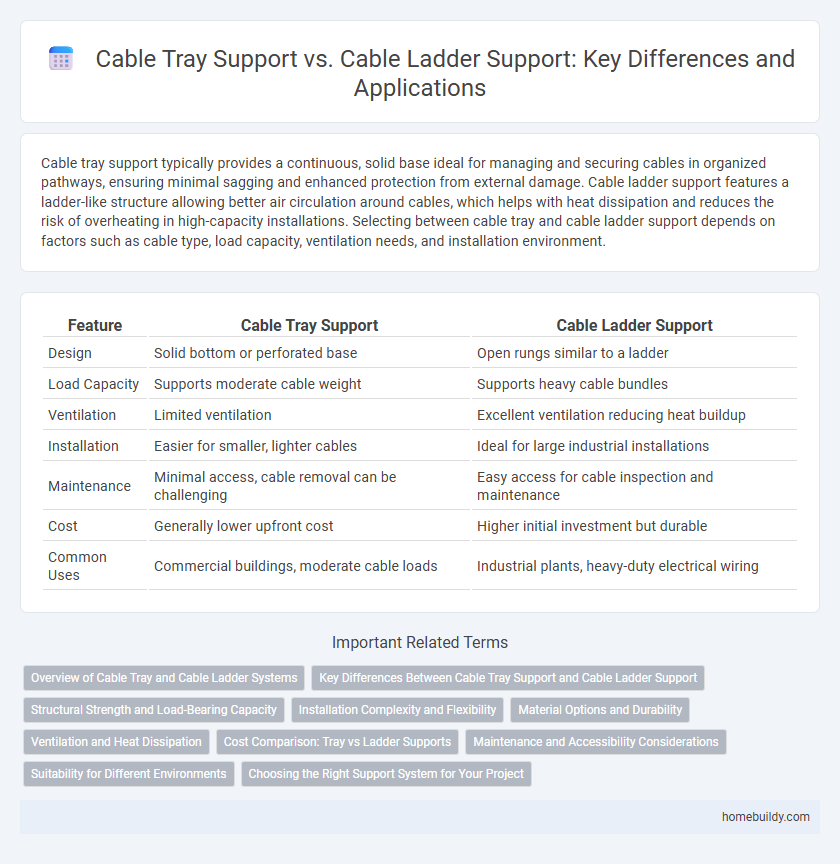Cable tray support typically provides a continuous, solid base ideal for managing and securing cables in organized pathways, ensuring minimal sagging and enhanced protection from external damage. Cable ladder support features a ladder-like structure allowing better air circulation around cables, which helps with heat dissipation and reduces the risk of overheating in high-capacity installations. Selecting between cable tray and cable ladder support depends on factors such as cable type, load capacity, ventilation needs, and installation environment.
Table of Comparison
| Feature | Cable Tray Support | Cable Ladder Support |
|---|---|---|
| Design | Solid bottom or perforated base | Open rungs similar to a ladder |
| Load Capacity | Supports moderate cable weight | Supports heavy cable bundles |
| Ventilation | Limited ventilation | Excellent ventilation reducing heat buildup |
| Installation | Easier for smaller, lighter cables | Ideal for large industrial installations |
| Maintenance | Minimal access, cable removal can be challenging | Easy access for cable inspection and maintenance |
| Cost | Generally lower upfront cost | Higher initial investment but durable |
| Common Uses | Commercial buildings, moderate cable loads | Industrial plants, heavy-duty electrical wiring |
Overview of Cable Tray and Cable Ladder Systems
Cable trays and cable ladders are essential components in cable management systems, designed to support and organize electrical cables efficiently. Cable trays consist of solid or perforated bottom panels that provide continuous support, ideal for heavier or sensitive cables requiring full protection, while cable ladders feature side rails connected by rungs, offering better ventilation and ease of cable installation and maintenance. Both systems enhance cable routing flexibility and safety but differ in load capacity, airflow, and suitability for specific cable types and environments.
Key Differences Between Cable Tray Support and Cable Ladder Support
Cable tray support systems provide a solid base for organizing cables in confined spaces, offering a continuous surface to securely hold wiring and reduce cable sagging. Cable ladder support systems feature rungs, allowing better ventilation and heat dissipation for cables, making them ideal for installations requiring airflow and easy cable access. The primary differences lie in load capacity, ventilation, installation environment, and maintenance accessibility, with cable trays better suited for tightly packed cables and cable ladders preferred for bulkier or heat-sensitive wiring.
Structural Strength and Load-Bearing Capacity
Cable tray supports provide reliable structural strength with a flat, continuous base ideal for lighter cable loads, ensuring even weight distribution and protection from bending. Cable ladder supports offer superior load-bearing capacity due to their open, rung-based design, which allows for better ventilation and can accommodate heavier cables and larger bundles without deformation. Selecting between cable tray and ladder support depends on specific load requirements and the necessity for ventilation or cable accessibility in installation environments.
Installation Complexity and Flexibility
Cable tray support systems typically offer simpler installation with fewer components and easier alignment, making them suitable for straight runs and limited structural adaptations. Cable ladder supports provide greater flexibility in cable management due to their open design and robust structure, allowing for easier cable routing, access, and modifications in complex or industrial environments. The choice between cable tray and ladder support depends on project requirements for installation speed, adaptability, and cable load capacity.
Material Options and Durability
Cable tray supports commonly utilize steel, aluminum, and fiberglass, offering robust corrosion resistance and high load capacity for diverse industrial applications. Cable ladder supports often feature galvanized steel or stainless steel, enhancing durability and providing superior strength for heavier cable loads in harsh environments. Both support types prioritize material selection to ensure long-term performance, with cable trays favoring lightweight and corrosion-resistant options and cable ladders emphasizing enhanced mechanical strength.
Ventilation and Heat Dissipation
Cable trays offer limited ventilation and heat dissipation due to their enclosed design, which can trap heat and reduce airflow around cables. In contrast, cable ladders provide superior ventilation and heat dissipation through their open structure, allowing air to circulate freely and preventing heat buildup. Enhanced airflow in cable ladder supports helps maintain optimal cable performance and extends the lifespan of electrical installations.
Cost Comparison: Tray vs Ladder Supports
Cable tray supports generally cost less than cable ladder supports due to simpler design and fewer materials required for installation. Cable ladders, with their open structure and enhanced load-bearing capacity, often involve higher initial investment and maintenance expenses. Choosing cable tray supports can optimize budget constraints while ensuring adequate cable management for light to medium loads.
Maintenance and Accessibility Considerations
Cable tray support systems offer easier maintenance access due to their solid bottom design, preventing cable sagging and simplifying cable organization. In contrast, cable ladder supports provide superior ventilation, reducing heat buildup but may require more effort during cable installation and maintenance because of their open rungs. Choosing between cable tray and cable ladder support impacts long-term accessibility and maintenance efficiency based on project-specific cable routing and environmental conditions.
Suitability for Different Environments
Cable tray support systems are ideal for indoor environments with limited space and moderate load requirements, offering easy installation and maintenance. Cable ladder supports are better suited for outdoor or industrial settings where heavy loads, better ventilation, and easy cable inspection are necessary. Environmental factors such as exposure to moisture, temperature fluctuations, and corrosive conditions influence the choice between cable tray and cable ladder supports to ensure durability and safety.
Choosing the Right Support System for Your Project
Cable tray supports provide a solid, enclosed pathway ideal for managing compact or sensitive cable bundles, offering enhanced protection against environmental factors compared to cable ladder supports. Cable ladder supports excel in ventilation and ease of cable installation, making them preferable for larger cable volumes or settings requiring frequent cable modifications. Selecting the right support system depends on project-specific factors such as cable type, load capacity, environmental exposure, and ease of maintenance.
Cable tray support vs cable ladder support Infographic

 homebuildy.com
homebuildy.com